Related Research Articles

Banksia is a genus of around 170 species in the plant family Proteaceae. These Australian wildflowers and popular garden plants are easily recognised by their characteristic flower spikes, and fruiting "cones" and heads. Banksias range in size from prostrate woody shrubs to trees up to 30 metres tall. They are found in a wide variety of landscapes: sclerophyll forest, (occasionally) rainforest, shrubland, and some more arid landscapes, though not in Australia's deserts.
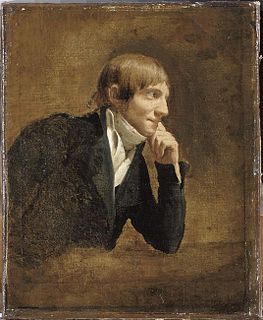
Pierre-Joseph Redouté, was a painter and botanist from Belgium, known for his watercolours of roses, lilies and other flowers at the Château de Malmaison, many of which were published as large, coloured stipple engravings. He was nicknamed "the Raphael of flowers" and has been called the greatest botanical illustrator of all time.

Sydney Parkinson was a Scottish botanical illustrator and natural history artist. He was the first European artist to visit Australia, New Zealand and Tahiti. Parkinson was the first Quaker to visit New Zealand. The standard author abbreviation Parkinson is used to indicate this person as the author when citing a botanical name.
John William Lewin was an English-born artist active in Australia from 1800. The first professional artist of the colony of New South Wales, he illustrated the earliest volumes of Australian natural history. Many of his illustrations were of native Australian birds on native Australian plants.

Alexander Segger George is a Western Australian botanist. He is the authority on the plant genera Banksia and Dryandra. The "bizarre" Restionaceae genus Alexgeorgea was named in his honour in 1976.
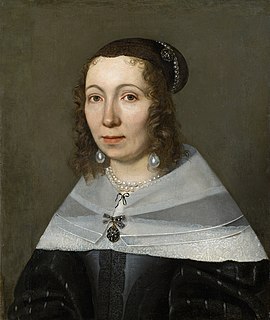
Maria Sibylla Merian was a German-born Swiss naturalist and scientific illustrator. She was one of the earliest European naturalists to observe insects directly. Merian was a descendant of the Frankfurt branch of the Swiss Merian family.

Banksia coccinea, commonly known as the scarlet banksia, waratah banksia or Albany banksia, is an erect shrub or small tree in the family Proteaceae. Its distribution in the wild is along the south west coast of Western Australia, from Denmark to the Stokes National Park, and north to the Stirling Range, growing on white or grey sand in shrubland, heath or open woodland. Reaching up to 8 m (26 ft) in height, it is a single-stemmed plant that has oblong leaves, which are 3–9 cm (1.2–3.5 in) long and 2–7 cm (0.8–2.8 in) wide. The prominent red and white flower spikes appear mainly in the spring. As they age they develop small follicles that store seeds until opened by fire. Though widely occurring, it is highly sensitive to dieback and large populations of plants have succumbed to the disease.

Banksia serrata, commonly known as the saw banksia, the old man banksia, the saw-tooth banksia or the red honeysuckle and as wiriyagan by the Cadigal people, is a species of woody shrub or tree of the genus Banksia, in the family Proteaceae. Native to the east coast of Australia, it is found from Queensland to Victoria with outlying populations on Tasmania and Flinders Island. Commonly growing as a gnarled tree up to 16 m (50 ft) in height, it can be much smaller in more exposed areas. This Banksia species has wrinkled grey bark, shiny dark green serrated leaves and large yellow or greyish-yellow flower spikes appearing over summer. The flower spikes, or inflorescences, turn grey as they age and pollinated flowers develop into large, grey, woody seed pods called follicles.

The Botanical Magazine; or Flower-Garden Displayed, is an illustrated publication which began in 1787. The longest running botanical magazine, it is widely referred to by the subsequent name Curtis's Botanical Magazine.
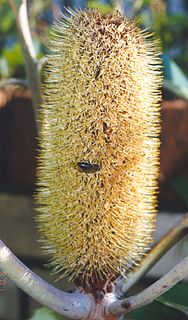
Banksia robur, commonly known as swamp banksia, or less commonly broad-leaved banksia, grows in sand or peaty sand in coastal areas from Cooktown in north Queensland to the Illawarra region on the New South Wales south coast. It is often found in areas which are seasonally inundated.
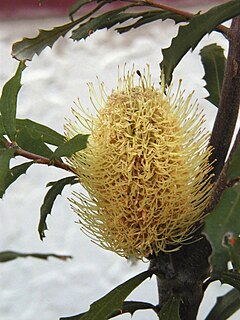
Banksia canei, commonly known as the mountain banksia, is a species of shrub that is endemic to southeastern Australia. It is generally encountered as a many-branched shrub that grows up to 3 m (10 ft) high, with narrow leaves and the yellow inflorescences appearing from late summer to early winter. The old flowers fall off the spikes and up to 150 finely furred follicles develop, which remain closed until burnt in a bushfire. Each follicle bears two winged seeds. Response to fire is poorly known, although it is thought to regenerate by seed. Birds such as the yellow-tufted honeyeater and various insects forage among the flower spikes. It is frost tolerant in cultivation, but copes less well with aridity or humidity and is often short-lived in gardens. One cultivar, Banksia 'Celia Rosser', was registered in 1978, but has subsequently vanished.

Banksia victoriae, commonly known as Woolly Orange Banksia, is a species of large shrub or small tree in the plant genus Banksia. It occurs in Western Australia between Northampton, Western Australia and Kalbarri, with the occasional plant further north as far as Zuytdorp Nature Reserve.
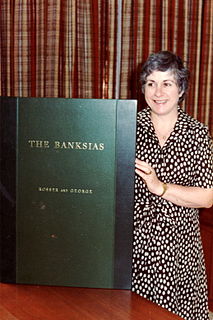
Celia Elizabeth Rosser is an Australian botanical illustrator, best known for having published The Banksias, a three-volume series of monographs containing watercolour paintings of every Banksia species.
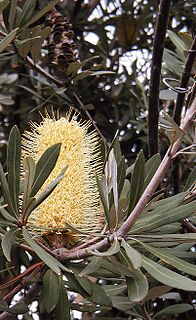
The taxonomy of Banksia integrifolia has a long and complex history, the result of confusion caused by the species' great variability, and similarities with some closely related species. The existence of hybrids between B. integrifolia and related species as well as early attempts to classify the species based on dried specimen material have also contributed to the confusion.

Banksia sect. Eubanksia is an obsolete section of Banksia. There have been two circumscriptions, one of which is synonymous with the recently abandoned B. subg. Banksiasensu Alex George, the other having no modern equivalent.

Botanical illustration is the art of depicting the form, color, and details of plant species, frequently in watercolor paintings. They must be scientifically accurate but often also have an artistic component and may be printed with a botanical description in books, magazines, and other media or sold as a work of art. Often composed by a botanical illustrator in consultation with a scientific author, their creation requires an understanding of plant morphology and access to specimens and references.

Sarah Anne Drake (1803–1857) was an English botanical illustrator who worked for John Lindley and collaborated with Augusta Innes Withers, Nathaniel Wallich and others.

Lambertia formosa, commonly known as mountain devil, is a shrub of the family Proteaceae, endemic to New South Wales, Australia. First described in 1798 by English botanist James Edward Smith, it is the type species of the small genus Lambertia. It is generally found in heathland or open forest, growing in sandstone-based soils. It grows as a multistemmed shrub to around 2 m (7 ft) with a woody base known as a lignotuber, from which it regrows after bushfire. It has stiff narrow leaves, and the pink to red flowerheads, made up of seven individual tubular flowers, generally appear in spring and summer. It gains its common name from the horned woody follicles, which were used to make small devil-figures.
Philippa Mary Nikulinsky is an artist and botanical illustrator based in Western Australia.
Barbara Mary Steyning Everard was a botanical illustrator whose work encompassed books, private commissions, botanical publications, gardening magazines, greetings cards and commemorative plates.
References
- ↑ "The Banksias" . Retrieved 25 March 2007.
- 1 2 "The Banksias: Watercolours". Studio International. Retrieved 25 March 2007.